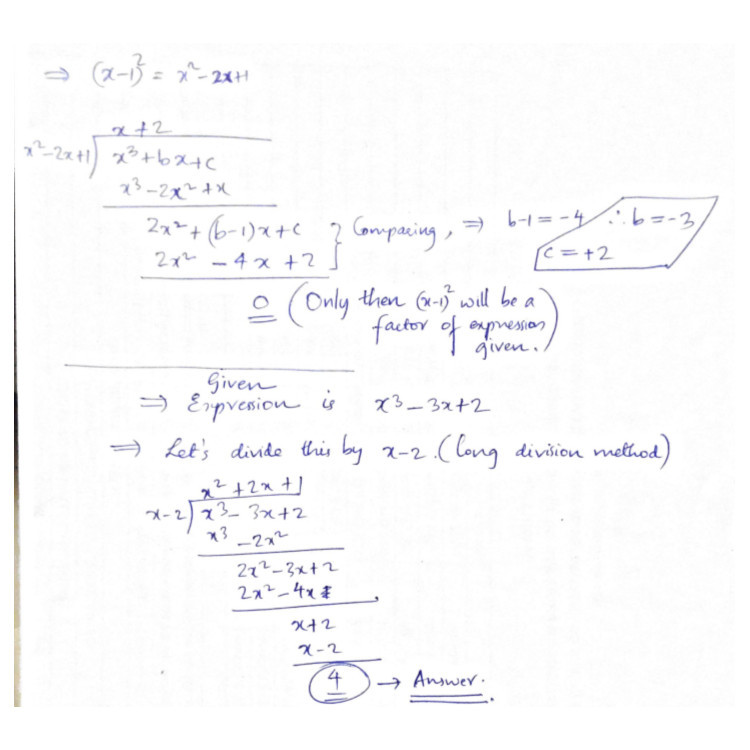Repeated root remainder
If f ( x ) = x 3 + b x + c and ( x − 1 ) 2 is a factor of f ( x ) .Then find remainder when f ( x ) is divided by x − 2 .
The answer is 4.
This section requires Javascript.
You are seeing this because something didn't load right. We suggest you, (a) try
refreshing the page, (b) enabling javascript if it is disabled on your browser and,
finally, (c)
loading the
non-javascript version of this page
. We're sorry about the hassle.
7 solutions
Moderator note:
By right, in the first line, you should say that f ( x ) = ( x − 1 ) 2 ( e x + d ) , and that by comparing leading coefficients we get that e = 1 .
What is another more direct way of finding that
d
=
−
2
without having to expand the polynomial?
Hint: How else do we know that
d
+
2
=
0
?
Sum of roots 1 + 1 + d = 0 , therefore d = − 2 .
In response to Challenge Master: Using Vieta's formulas.
Log in to reply
The better way to do this question is to use some calculus. It is really very efficient.
This was a great method! :D
I did this by method of "forcing the factor":
f ( x ) = x 3 + b x + c ⇒ f ( x ) = x 3 − 2 x 2 + x + 2 x 2 − x + b x + c ⇒ f ( x ) = x ( x 2 − 2 x + 1 ) + 2 x 2 + x ( b − 1 ) + c ⇒ f ( x ) = x ( x − 1 ) 2 + 2 ( x 2 − x ( 2 b − 1 ) + 2 c )
Since ( x − 1 ) 2 ∣ f ( x ) we have:
x 2 − x ( 2 b − 1 ) + 2 c = x 2 − 2 x + 1 ⇒ ( 2 b − 1 ) = − 2 , 2 c = 1 ⇒ b = − 3 , c = 2
So we have f ( x ) = x 3 − 3 x + 2 .By Remainder theorem ,
f ( 2 ) = 2 3 − 3 ( 2 ) + 2 = 8 − 6 + 2 = 2 + 2 = 4
Remainder when we divide f ( x ) by ( x − 1 ) 2 is zero. Therefore − 1 = b + c .
Now remainder when f ( x ) is divided by x − 2 is 8 + 2 b + c i.e 7 + b .
Now we know by factor theorem that f ( x ) = ( x − 1 ) 2 ∗ q ( x ) .
q ( x ) must be linear so let q ( x ) = x − z .
Therefore f ( x ) = ( x − 1 ) 2 ( x − z )
Now x 3 + b x + x = x 3 − 2 x 2 + x − z x 2 + 2 x z − z
Comparing quadratic terms coef on both sides we get − ( 2 + z ) = 0 i.e z = − 2 .
Now we compare linear terms we get b = 1 + 2 z = 1 + 2 ∗ ( − 2 ) = 1 − 4 = − 3
Therefore our remainder is 7 + b = 7 − 3 = 4 .
Nice, did it the same way. :)
I really can't believe! Yesterday this problem was level 5 but level 2 today!
I just divided x-1 with f(x) to get quotient x^2+x+(b+1) now we know this is also divisible by x-1 so we put x=1 in that to get b=-3 and we also know b+c=-1 so we get c=2 and we substitute x=2 in f(x) to get 4
We can use the fact that f(1) as well as derivative of f(1) are 0
Moderator note:
Right, can you elaborate on it?
In response to challenge master : Using the fact that for a polynomial, if x=a is repeated root then it must be a root of its derivative too.It is a result of Rolle's theorem in limiting situation.
Since x=1 is repeated root of the polynomial f(x), therefore, f(x)=0 and f'(x)=0 at x=1. Solving the two equations f(1)=0 and f'(1) =0 we get b=-3 and c=2. substituting these values we have, f(x)= x^3-3x+2. Apply remainder theorem to get the required remainder which is f(2)=4
Super easy solution :

Since ( x − 1 ) 2 is a factor of f ( x ) then, f ( x ) = ( x − 1 ) 2 ( x − d ) , where d is a real constant. Therefore,
f ( x ) ⇒ x 3 + b x + c = ( x − 1 ) 2 ( x − d ) = ( x − 1 ) 2 ( x − d ) = ( x 2 − 2 x + 1 ) ( x − d ) = x 3 − ( d + 2 ) x 2 + ( 2 d + 1 ) x − d
Equating coefficients of both sides, we have, d + 2 = 0 ⇒ d = − 2 . Therefore, we have:
f ( x ) ⇒ f ( 2 ) = ( x − 1 ) 2 ( x − d ) = ( 2 − 1 ) 2 [ 2 − ( − 2 ) ] = 4